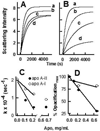Apolipoprotein modulation of streptococcal serum opacity factor activity against human plasma high-density lipoproteins
- PMID: 19618959
- PMCID: PMC3236702
- DOI: 10.1021/bi901087z
Apolipoprotein modulation of streptococcal serum opacity factor activity against human plasma high-density lipoproteins
Abstract
Human plasma HDL are the target of streptococcal serum opacity factor (SOF), a virulence factor that clouds human plasma. Recombinant (r) SOF transfers cholesteryl esters (CE) from approximately 400,000 HDL particles to a CE-rich microemulsion (CERM), forms a cholesterol-poor HDL-like particle (neo HDL), and releases lipid-free (LF) apo A-I. Whereas the rSOF reaction requires labile apo A-I, the modulation effects of other apos are not known. We compared the products and rates of the rSOF reaction against human HDL and HDL from mice overexpressing apos A-I and A-II. Kinetic studies showed that the reactivity of various HDL species is apo-specific. LpA-I reacts faster than LpA-I/A-II. Adding apos A-I and A-II inhibited the SOF reaction, an effect that was more profound for apo A-II. The rate of SOF-mediated CERM formation was slower against HDL from mice expressing human apos A-I and A-II than against WT mice HDL and slowest against HDL from apo A-II overexpressing mice. The lower reactivity of SOF against HDL containing human apos is due to the higher hydropathy of human apo A-I, particularly its C-terminus relative to mouse apo A-I, and the higher lipophilicity of human apo A-II. The SOF-catalyzed reaction is the first to target HDL rather than its transporters and receptors in a way that enhances reverse cholesterol transport (RCT). Thus, effects of apos on the SOF reaction are highly relevant. Our studies show that the "humanized" apo A-I-expressing mouse is a good animal model for studies of rSOF effects on RCT in vivo.
Figures








Similar articles
-
Disruption of human plasma high-density lipoproteins by streptococcal serum opacity factor requires labile apolipoprotein A-I.Biochemistry. 2009 Feb 24;48(7):1481-7. doi: 10.1021/bi802287q. Biochemistry. 2009. PMID: 19191587 Free PMC article.
-
Serum opacity factor unmasks human plasma high-density lipoprotein instability via selective delipidation and apolipoprotein A-I desorption.Biochemistry. 2007 Nov 13;46(45):12968-78. doi: 10.1021/bi701525w. Epub 2007 Oct 17. Biochemistry. 2007. PMID: 17941651 Free PMC article.
-
Apolipoprotein AI deficiency inhibits serum opacity factor activity against plasma high density lipoprotein via a stabilization mechanism.Biochemistry. 2015 Apr 14;54(14):2295-302. doi: 10.1021/bi501486z. Epub 2015 Apr 2. Biochemistry. 2015. PMID: 25790332 Free PMC article.
-
Apolipoprotein A-II, HDL metabolism and atherosclerosis.Atherosclerosis. 2002 Sep;164(1):1-13. doi: 10.1016/s0021-9150(01)00751-1. Atherosclerosis. 2002. PMID: 12119188 Review.
-
Apolipoprotein A-II is a key regulatory factor of HDL metabolism as appears from studies with transgenic animals and clinical outcomes.Biochimie. 2014 Jan;96:56-66. doi: 10.1016/j.biochi.2013.08.027. Epub 2013 Sep 5. Biochimie. 2014. PMID: 24012775 Review.
Cited by
-
Comparison of apoA-I helical structure and stability in discoidal and spherical HDL particles by HX and mass spectrometry.J Lipid Res. 2013 Jun;54(6):1589-1597. doi: 10.1194/jlr.M034785. Epub 2013 Apr 10. J Lipid Res. 2013. PMID: 23580759 Free PMC article.
-
Opacification Domain of Serum Opacity Factor Inhibits Beta-Hemolysis and Contributes to Virulence of Streptococcus pyogenes.mSphere. 2017 Apr 19;2(2):e00147-17. doi: 10.1128/mSphereDirect.00147-17. eCollection 2017 Mar-Apr. mSphere. 2017. PMID: 28435893 Free PMC article.
-
Influence of apolipoprotein A-I and apolipoprotein A-II availability on nascent HDL heterogeneity.J Lipid Res. 2013 Dec;54(12):3464-70. doi: 10.1194/jlr.M043109. Epub 2013 Oct 1. J Lipid Res. 2013. PMID: 24089247 Free PMC article.
-
Speciated human high-density lipoprotein protein proximity profiles.Biochemistry. 2010 Dec 21;49(50):10656-65. doi: 10.1021/bi1015452. Epub 2010 Nov 23. Biochemistry. 2010. PMID: 21073165 Free PMC article.
-
The structure and function of serum opacity factor: a unique streptococcal virulence determinant that targets high-density lipoproteins.J Biomed Biotechnol. 2010;2010:956071. doi: 10.1155/2010/956071. Epub 2010 Jul 8. J Biomed Biotechnol. 2010. PMID: 20671930 Free PMC article. Review.
References
-
- Cuchel M, Rader DJ. Macrophage reverse cholesterol transport: key to the regression of atherosclerosis. Circulation. 2006;113:2548–2555. - PubMed
-
- Curtiss LK, Valenta DT, Hime NJ, Rye KA. What is so special about apolipoprotein AI in reverse cholesterol transport? Arterioscler Thromb Vasc Biol. 2006;26:12–19. - PubMed
-
- Havel RJ, Goldstein JL, Brown MS. Lipoproteins in Lipid Transport. 1980:398–494.
-
- Rader DJ, Castro G, Zech LA, Fruchart JC, Brewer HB., Jr In vivo metabolism of apolipoprotein A-I on high density lipoprotein particles LpA-I and LpA-I,A-II. J Lipid Res. 1991;32:1849–1859. - PubMed
-
- Huang Y, von Eckardstein A, Wu S, Assmann G. Cholesterol efflux, cholesterol esterification, and cholesteryl ester transfer by LpA-I and LpA-I/A-II in native plasma. Arterioscler Thromb Vasc Biol. 1995;15:1412–1418. - PubMed
Publication types
MeSH terms
Substances
Grants and funding
LinkOut - more resources
Full Text Sources
Miscellaneous

